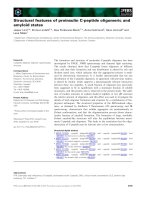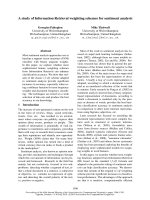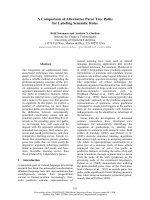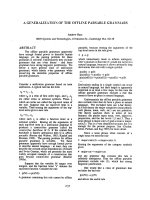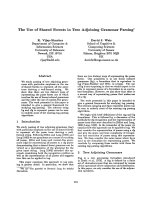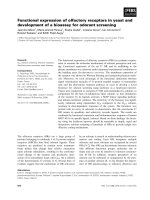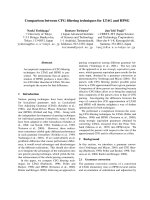Báo cáo khoa học: "A Bag of Useful Techniques for Efficient and Robust Parsing" ppt
Bạn đang xem bản rút gọn của tài liệu. Xem và tải ngay bản đầy đủ của tài liệu tại đây (792.11 KB, 8 trang )
A Bag of Useful Techniques for Efficient and Robust Parsing
Bernd Kiefer t, Hans-Ulrich Kriegert, John Carroll $, and Rob Malouff
IGerman Research Center for Artificial Intelligence (DFKI)
Stuhlsatzenhausweg 3, D-66123 Saarbriicken
$Cognitive and Computing Sciences, University of Sussex
Falmer, Brighton BN1 9QH, UK
*Center for the Study of Language and Information, Stanford University
Ventura Hall, Stanford, CA 94305-4115, USA
{kiefer, krieger}@dfki, de, j ohnca@cogs, susx. ac. uk, malouf@csli, stanford, edu
Abstract
This paper describes new and improved tech-
niques which help a unification-based parser to
process input efficiently and robustly. In com-
bination these methods result in a speed-up in
parsing time of more than an order of magni-
tude. The methods are correct in the sense that
none of them rule out legal rule applications.
1 Introduction
This paper describes several generally-
applicable techniques which help a unification-
based parser to process input efficiently and
robustly. As well as presenting a number of new
methods, we also report significant improve-
ments we have made to existing techniques.
The methods preserve correctness in the sense
they do not rule out legal rule applications.
In particular, none of the techniques involve
statistical or approximate processing. We also
claim that these methods are independent
of the concrete parser and neutral with re-
spect to a given unification-based grammar
theory/formalism.
How can we gain reasonable efficiency in pars-
ing when using large integrated grammars with
several thousands of huge lexicon entries? Our
belief is that there is no single method which
achieves this goal alone. Instead, we have to
develop and use a set of "cheap" filters which
are correct in the above sense. As we indicate
in section 10, combining these methods leads
to a speed-up in parsing time (and reduction of
space consumption) of more than an order of
magnitude when applied to a mature, well en-
gineered unification-based parsing system.
We have implemented our methods as exten-
sions to a HPSG grammar development environ-
ment (Uszkoreit et al., 1994) which employs a
sophisticated typed feature formalism (Krieger
and Sch~ifer, 1994; Krieger and Sch~ifer, 1995)
and an advanced agenda-based bottom-up chart
parser (Kiefer and Scherf, 1996). A special-
ized runtime version of this system is currently
used in VERBMOBIL as the primary deep anal-
ysis component. I
In the next three sections, we report on trans-
formations we have applied to the knowledge
base (grammar/lexicon) and on modifications
in the core formalism (unifier, type system). In
Section 5-8, we describe how a given parser can
be extended to filter out possible rule applica-
tions efficiently before performing "expensive"
unification. Section 9 shows how to compute
best partial analyses in order to gain a certain
level of robustness. Finally, we present empir-
ical results to demonstrate the efficiency gains,
and speculate on extensions we intend to work
on in the near future. Within the different sec-
tions, we refer to three corpora we have used to
measure the effects of our methods. The refer-
ence corpora for English, German, and Japanese
consist of 1200-5000 samples.
2 Precompiling the Lexicon
Lexicon entries in the development system are
small templates that are loaded and expanded
on demand by the typed feature structure sys-
tem. Thereafter, all lexical rules are applied to
the expanded feature structures. The results of
these two computations form the input of the
analysis stage.
1VERBMOBIL
(Wahlster, 1993) deals with the trans-
lation of spontaneously spoken dialogues, where only a
minor part consists of "sentences" in a linguistic sense.
Current languages are English, German, and Japanese.
Some of the methods were originally developed in the
context of another HPSG environment, the LKB (Copes-
take, 1998). This lends support to our claims of their in-
dependence from a particular parser or grammar engine.
473
In order to save space and time in the run-
time system, the expansion and the application
of lexical rules is now done off-line. In addi-
tion, certain parts of the feature structure are
deleted, since they are only needed to restrict
the application of lexical rules (see also section
7 for a similar approach). For each stem, all
results are stored in compact form as one com-
piled LISP file, which allows to access and load
a requested entry rapidly with almost no restric-
tion on the size of the lexicon. Although load
time is small (see figure 1), the most frequently
used entries are cached in main memory, reduc-
ing effort in the lexicon stage to a minimum.
We continue to compute morphological infor-
mation online, due to the significant increase of
entries (a factor of 10 to 20 for German), which
is not justifiable considering the minimal com-
putation time for this operation.
German English Japanese
# stems 4269 3754 1875
space 10.3 KB 10.8 KB 5.4 KB
entries 6 2.2 2.1
load time 25.8 msec 29.5 msec 7.5 msec
Figure 1: Space and time requirements, space,
entries and load time values are per stem
3 Improvements in unification
Unification is the single most expensive oper-
ation performed in the course of parsing. Up
to 90% of the CPU time expended in parsing
a sentence using a large-scale unification based
grammar can go into feature structure and type
unification. Therefore, any improvements in the
efficiency of unification would have direct conse-
quences for the overall performance of the sys-
tem.
One key to reducing the cost of unification is
to find the simplest set of operations that meet
the needs of grammar writers but still can be
efficiently implemented. The unifier which was
part of the original HPSG grammar develop-
ment system mentioned in the introduction (de-
scribed by (Backofen and Krieger, 1993)) pro-
vided a number of advanced features, including
distributed (or named) disjunctions (D6rre and
Eisele, 1990) and support for full backtracking.
While these operations were sometimes useful,
they also made the unifier much more complex
than was really necessary.
The unification algorithm used by the cur-
rent system is a modification of Tomabechi's
(Tomabechi, 1991) "quasi-destructive" unifica-
tion algorithm. Tomabechi's algorithm is based
on the insight that unification often fails, and
copying should only be performed when the uni-
fication is going to succeed. This makes it par-
ticularly well suited to chart-based parsing.
During parsing, each edge must be built with-
out modifying the edges that contribute to it.
With a non-backtracking unifier, one option is
to copy the daughter feature structures before
performing a destructive unification operation,
while the other is to use a non-destructive al-
gorithm that produces a copy of the result up
to the point a failure occurs. Either approach
will result in some structures being built in the
course of an unsuccessful unification, wasting
space and reducing the overall throughput of
the system. Tomabechi avoids these problems
by simulating non-destructiveness without in-
curring the overhead necessary to support back-
tracking. First, it performs a destructive (but
reversible) check that the two structures are
compatible, and only when that succeeds does
it produce an output structure. Thus, no out-
put structures are built until it is certain that
the unification will ultimately succeed.
While an improvement over simple destruc-
tive unification, Tomabechi's approach still suf-
fers from what Kogure (Kogure, 1990) calls re-
dundant copying. The new feature structures
produced in the second phase of unification in-
clude copies of all the substructures of the in-
put graphs, even when these structures are un-
changed. This can be avoided by reusing parts
of the input structures in the output structure
(Carroll and Malouf, 1999) without introducing
significant bookkeeping overhead.
To keep things as simple and efficient as pos-
sible, the improved unifier also only supports
conjunctive feature structures. While disjunc-
tions can be a convenient descriptive tool for
writing grammars, they are not absolutely nec-
essary. When using a typed grammar formal-
ism, most disjunctions can be easily put into the
type hierarchy. Any disjunctions which cannot
be removed by introducing new supertypes can
be eliminated by translating the grammar into
474
disjunctive normal form (DNF). Of course, the
ratio of the number of rules and lexical entries in
the original grammar and the DNFed grammar
depends on the 'style' of the grammar writer,
the particular grammatical theory used, the
number of disjunction alternatives, and so on.
However, context management for distributed
disjunctions requires enormous overhead when
compared to simple conjunctive unification, so
the benefits of using a simplified unifier out-
weigh the cost of moving to DNF. For the Ger-
man and Japanese
VERBMOBIL
grammars, we
got 1.4-3× more rules and lexical entries, but
by moving to a sophisticated conjunctive unifier
we obtained an overall speed-up of 2-5.
4 Precompiling Type Unification
After changing the unification engine, type uni-
fication now became a big factor in processing:
nearly 50% of the overall unification and copy-
ing time was taken up by the computation of
the greatest lower bounds (GLBs). Although
we have in the past computed GLBs online effi-
ciently with bit vectors, off-line computation is
of course superior.
The feasibility of the latter method depends
on the number of types T of a grammar. The
English grammar employs 6000 types which re-
sults in 36,000,000 possible GLBs. Our exper-
iments have shown, however, that only 0.5%-
2% of the type unifications were successful and
only these GLBs need to be entered into the
GLB table. In our implementation, accessing
an arbitrary GLB takes less than 0.002 msec,
compared to 15 msec of 'expensive' bit vector
computation (following (A'/t-Kaci et al., 1989))
which also produces a lot of memory garbage.
Our method, however, does not consume any
memory and works as follows. We first assign
a unique code (an integer) to every type t E 7
After that, the GLB of s and t is assigned
the following code (again an integer, in fact a
fixnum):
code(s) × ITI + code(t).
This array-
like encoding guarantees that a specific code is
given away to a GLB at most once. Finally, this
code together with the GLB is stored in a hash
table. Hence, type unification costs are mini-
mized: two symbol table lookups, one addition,
one multiplication, and a hash table lookup.
In order to access a unique maximal lower
bound (= GLB), we must require that the type
hierarchy is a lower semilattice (or bounded
complete partial order). This is often not the
case, but this deficiency can be overcome either
by pre-computing the missing types (an efficient
implementation of this takes approximately 25
seconds for the English grammar) or by making
the online table lookup more complex.
A naive implementation of the off-line compu-
tation (compute
the GLBs for T × T)
only works
for small grammars. Since type unification is
a commutative operation
(glb(s,t) = glb(t,
s);
s,t
E 7"), we can improve the algorithm by
computing only
glb(s,t).
A second improve-
ment is due to the following fact: if the GLB
of s and t is bottom, we do not have to com-
pute the GLBs of the subtypes of both s and
t, since they guarantee to fail. Even with these
improvements, the GLB computation of a spe-
cific grammar took more than 50 CPU hours,
due to the special 'topology' of the type hierar-
chy. However, not even the failing GLBs need
to be computed (which take much of the time).
When starting with the leaves of the type hi-
erarchy, we can compute maximal components
w.r.t, the supertype relation: by following the
subsumption links upwards, we obtain sets of
types, s.t. for a given component C, we can
guarantee that
glb(s,t) ~ _k,
for all
s,t E C.
This last technique has helped us to drop the
off-line computation time to less than one CPU
hour.
Overall when using the off-line GLBs, we ob-
tained a parsing speed-up of 1.5, compared to
the bit vector computation. 2
5 Precompiling Rule Filters
The aim of the methods described in this and
the next section is to avoid failing unifications
by applying cheap 'filters' (i.e., methods that
are cheaper than unification). The first filter
we want to describe is a rule application filter.
We have used this method for quite a while, and
it has proven both efficient and easy to employ.
Our rule application filter is a function that
2An alternative approach to improving the speed of
type unification would be to implement the GLB table
as a cache, rather than pre-computing the table's con-
tents exhaustively. Whether this works well in practice
or not depends on the efficiency of the primitive
glb(s, t)
computation; if the latter were relatively slow then the
parser itself would run slowly until the cache was suffi-
ciently full that cache hits became predominant.
475
takes two rules and an argument position and
returns a boolean value that specifies if the sec-
ond rule can be unified into the given argument
position of the first rule.
Take for example the binary filler-head rule
in the HPSG grammar for German. Since
this grammar allows not more than one el-
ement on the SLASH list, the left hand side
of the rule specifies an empty list as SLASH
value. In the second (head) argument of the
rule, SLASH has to be a list of length one.
Consequently, a passive chart item whose top-
most rule is a filler-head rule, and so has an
empty SLASH, can not be a valid second ar-
gument for another filler-head rule application.
The filter function, when called with argu-
ments
(filler-head-rule-nr, filler-head-rule-nr, 2 )
for mother rule, topmost rule of the daughter
and argument position respectively, will return
false and no unification attempt will be made.
The conjunctive grammars have between 20
and 120 unary and binary rule schemata. Since
all rule schemata in our system bear a unique
number, this filter can be realized as a three di-
mensional boolean array. Thus, access costs are
minimized and no additional memory is used at
run-time. The filters for the three languages are
computed off-line in less than one minute and
rule out 50% to 60% of the failing unifications
during parsing, saving about 45% of the parsing
time.
6 Dynamic Unification Filtering
('Quick Check')
Our second filter (which we have dubbed the
'quick check') exploits the fact that unification
fails more often at certain points in feature
structures than at others. For example, syn-
tactic features such as CAW(egory) are very fre-
quent points of failure, whereas unification al-
most never fails on semantic features which are
used merely to accumulate pieces of the logical
form. Since all substructures are typed, uni-
fication failure is manifested by a type clash
when attempting a type unification. The quick
check is invoked before each unification attempt
to check the most frequent failure points, each
stored as a feature
path.
The technique works as follows. First, there
is an off-line stage, in which a modified unifi-
cation engine is used that does not return im-
mediately after a single type unification failure,
but instead records in a global data structure
the paths at which all such failures occurred.
Using this modified system a set of sentences is
parsed, and the n paths with the highest failure
counts are saved. It is exactly these paths that
are used later in filtering.
During parsing, when an active chart item
(i.e., a rule schema or a partly instantiated rule
schema) and a passive chart item (a lexical entry
or previously-built constituent) are combined,
the parser has to unify the feature structure of
the passive item into the substructure of the ac-
tive item that corresponds to the argument to
be filled. If either of the two structures has not
been seen before, the parser associates with it
a vector of length n containing the types at the
end of the previously determined paths. The
first position of the vector contains the type cor-
responding to the most frequently failing path,
the second position the second most frequently
failing path, and so on. Otherwise, the existing
vectors of types are retrieved. Corresponding
elements in the vectors are then type-unified,
and full unification of the feature structures is
performed only if all the type unifications suc-
ceed.
Clearly, when considering the number of
paths n used for this technique, there is a trade-
off between the time savings from filtered uni-
fications and the effort required to create the
vectors and compare them. The main factors
involved are the speed of type unification and
the percentage of unification attempts filtered
out (the 'filter rate') with a given set of paths.
The optimum number of paths cannot be de-
termined analytically. Our English, German
and Japanese grammars use between 13 to 22
paths for quick check filtering, the precise num-
ber having been established by experimenta-
tion. The paths derived for these grammars are
somewhat surprising, and in many cases do
not
fit in with the intuitions of the grammar-writers.
In particular, some of the paths are very long
(of length ten or more). Optimal sets of paths
for grammars of this complexity could not be
produced manually.
The technique will only be of benefit if type
unification is computationally cheap as indeed
it is in our implementation (section 4) and if
the filter rate is high (otherwise the extra work
476
performed essentially just duplicates work car-
ried out later in unification). There is also over-
lap between the quick check and the rule filter
(previous section) since they are applied at the
same point in processing. We have found that
(given a reasonable number of paths) the quick
check is the more powerful filter of the two be-
cause it functions dynamically, taking into ac-
count feature instantiations that occur during
the parsing process, but that the rule filter is
still valuable if executed first since it is a single,
very fast table lookup. Applying both filters,
the filter rate ranges from 95% to over 98%.
Thus almost all failing unifications are avoided.
Compared to the system with only rule applica-
tion filtering, parse time is reduced by approxi-
mately 75% 3 .
7 Reducing Feature Structure Size
via
Restrictors
The 'category' information that is attached to
each chart item of the parser consists of a single
feature structure. Thus a rule is implemented
by a feature structure where the daughters have
to be unified into predetermined substructures.
Although this implementation is along the lines
of HPSG, it has the drawback that the tree
structure that is already present in the chart
items is duplicated in the feature structures.
Since HPSG requires all relevant informa-
tion to be contained in the
SYNSEM
feature of
the mother structure, the unnecessary daugh-
ters only increase the size of the overall feature
structure without constraining the search space.
Due to the Locality Principle of HPSG (Pollard
and Sag, 1987, p. 145ff), they can therefore be
legally removed in fully instantiated items. The
situation is different for active chart items since
daughters can affect their siblings.
To be independent from a-certain grammati-
cal theory or implementation, we use restrictors
similar to (Shieber, 1985) as a flexible and easy-
to-use specification to perform this deletion. A
positive restrictor is an automaton describing
the paths in a feature structure that will re-
main after restriction (the deletion operation),
3There are refinements of the technique which we
have implemented and which in practice produce ad-
ditional benefits; we will report these in a subsequent
paper. Briefly, they involve an improvement to th e path
collection method, and the storage of other information
besides types in the vectors.
whereas a negative restrictor specifies the parts
to be deleted. Both kinds of restrictors can be
used in our system.
In addition to the removal of the tree struc-
ture, the grammar writer can specify the re-
strictor further to remove features that are only
used locally and do not play a role in further
derivation. It is worth noting that this method
is only correct if the specified restrictor does not
remove paths that would lead to future unifica-
tion failures. The reduction in size results in a
speed-up in unification itself, but also in copy-
ing and memory management.
As already mentioned in section 2, there ex-
ists a second restrictor to get rid of unnecessary
parts of the lexical entries after lexicon process-
ing. The speed gain using the restrictors in
parsing ranges from 30% for the German sys-
tem to 45% for English.
8
Limiting the Number of Initial
Chart Items
Since the number of lexical entries per stem has
a direct impact on the number of parsing hy-
potheses (in the worst case leads to an expo-
nential increase), it would be a good idea to
have a cheap mechanism at hand that helps to
limit these initial items. The technique we have
implemented is based on the following observa-
tion: in order to contribute to a reading, certain
items (concrete lexicon entries, but also classes
of entries) require the existence of other items
such that the non-existence of one allows a safe
deletion of the other (and vice versa). In Ger-
man, for instance, prefix verbs require the right
separable prefixes to be present in the chart, but
also a potential prefix requires its prefix verb.
Note that such a technique operates in a much
larger context (in fact, the whole chart) than a
local rule application filter or the quick-check
method. The method works as follows. In a
preprocessing step, we first separate the chart
items which encode prefix verbs from those
items which represent separable prefixes. Since
both specify the morphological form of the pre-
fix, a set-exclusive-or operation yields exactly
the items which can be safely deleted from the
chart.
Let us give some examples to see the useful-
ness of this method. In the sentence Ich komme
mo,'ge,~ (I (will) come tomorrow), komme maps
477
onto 97 lexical entries remember, komme
might encode prefix verbs such as ankommen
(arrive), zuriickkommen (come back), etc. al-
though here, none of the prefix verb readings
are valid, since a prefix is missing. Using the
above method, only 8 of 97 lexical entries will
remain in the chart. The sentence Ich komme
morgen an (I (will) arrive tomorrow) results in
8+7 entries for komme (8 entries for the come
reading together with 7 entries for the arrive
reading of komme) and 3 prepositional read-
ings plus 1 prefix entry for an. However in Der
Mann wartet an der Tiir (The man is waiting
at the door), only the three prepositional read-
ings for an come into play, since no prefix verb
anwartet exists. Although there are no English
prefix verbs, the method also works for verbs
requiring certain particles, such as come, come
along, come back, come up, etc.
The parsing time for the second example goes
down by a factor of 2.4; overall savings w.r.t, our
reference corpus is 17% of the parsing time (i.e.,
speed-up factor of 1.2).
9 Computing Best Partial Analyses
Given deficient, ungrammatical, or spontaneous
input, a traditional parser is not able to de-
liver a useful result. To overcome this disadvan-
tage, our approach focuses on partial analyses
which are combined in a later stage to form to-
tal analyses without giving up the correctness
of the overall deep grammar. But what can be
considered good partial analyses? Obviously a
(sub)tree licensed by the grammar which covers
a continuous part of the input (i.e., a passive
parser edge). But not every passive edge is a
good candidate since otherwise we would end up
with perhaps thousands of them. Instead, our
approach computes an 'optimal' connected se-
quence of partial analyses which cover the whole
input. The idea here is to view the set of pas-
sive edges as a directed graph and to compute
shortest paths w.r.t, a user-defined estimation
function.
Since this graph is acyclic and topologically
sorted, we have chosen the DAG-shortest-path
algorithm (Cormen et al., 1990) which runs in
O(V + E). We have modified this algorithm
to cope with the needs we have encountered in
speech parsing: (i) one can use several start and
~nd vertices (e.g., in case of n-best chains or
word graphs); (ii) all best shortest paths are
returned (i.e., we obtain a shortest-path sub-
graph); (iii) estimation and selection of the best
edges is done incrementally when parsing n-
best chains (i.e., only new passive edges entered
into the chart are estimated and perhaps se-
lected). This approach has one important prop-
erty: even if certain parts of the input have not
undergone at least one rule application, there
are still lexical edges which help to form a best
path through the passive edges. This means
that we can interrupt parsing at any time, but
still obtain a useful result.
Let us give an example to see how the estima-
tion function on edges ( trees) might look like
(this estimation is actually used in the German
grammar):
•
n-ary tree (n > 1) with utterance status
(e.g., NPs, PPs): value 1
• lexical items: value 2
• otherwise: value c~
This approach does not always favor paths
with longest edges as the example in figure 2
shows instead it prefers paths containing no
lexical edges (where this is possible) and there
might be several such paths having the same
cost. Longest (sub)paths, however, can be ob-
tained by employing an exponential estimation
function. Other properties, such as prosodic
information or probabilistic scores could also
be utilized in the estimation function. A de-
tailed description of the approach can be found
in (Kasper et al., 1999).
P R
S
Figure 2: Computing best partial analyses.
Note that the paths PR and QR are chosen,
but not ST, although S is the longest edge.
478
10
Conclusions and
Further Work
The collection of methods described in this pa-
per has enabled us to unite deep linguistic anal-
ysis with speech processing. The overall speed-
up compared to the original system is about a
factor of 10 up to 25. Below we present some
absolute timings to give an impression of the
current systems' performance.
German English Japanese
# sentences 5106 1261 1917
# words 7 6.7 7.2
# lex. entries 40.9 25.6 69.8
# chart items 1024 234 565
# results 5.8 12.4 53.6
time first 1.46 s 0.24 s 0.9 s
time overall 4.53 s 1.38 s 4.42 s
In the table, the last six rows are average val-
ues per sentence,
time first
and
time overall
are the mean CPU times to compute the first
result and the whole search space respectively.
# lex. entries and # chart items
give an im-
pression of the lexical and syntactic ambiguity
of the respective grammars 4
The German and Japanese corpora and half
of the English corpus consist of transliterations
of spoken dialogues used in the VEI:tBMOBIL
project. These dialogues are real world dia-
logues about appointment scheduling and va-
cation planning. They contain a variety of syn-
tactic as well as spontaneous speech phenom-
ena. The remaining half of the English corpus
is taken from a manually constructed test suite,
which may explain some of the differences in
absolute parse time.
Most of the methods are corpus independent,
except for the quick check filter, which requires
a training corpus, and the use of a purely con-
junctive grammar, which will do worse in cases
of great amounts of syntactic ambiguity because
there is currently no ambiguity packing in the
parser. For the quick check, we have observed
that a random subset of the corpora with about
one to two hundred sentences is enough to ob-
tain a filter with nearly optimal filter rate.
Although the actual efficiency gain will vary
for differently implemented grammars, we are
4The computations were made using a 300MHz SUN
Ultrasparc 2 with Solaris 2.5. The whole system is pro-
grammed in Franz Allegro Common Lisp.
certain that these techniques will lead to sub-
stantial improvements in almost every unifica-
tion based system. It is, for example, quite un-
likely that unification failures are equally dis-
tributed over the different nodes of the gram-
mar's feature structure, which is the most im-
portant prerequisite for the quick check filter to
work. Avoiding disjunctions usually requires a
reworking of the grammar which will pay off in
the end.
We have shown that the combination of al-
gorithmic methods together with some disci-
pline in grammar writing can lead to a practi-
cal high performance analysis system even with
large general grammars for different languages.
There is, however, room for further improve-
ments. We intend to generalize to other cases
the technique for removing unnecessary lexical
items. A detailed investigation of the quick-
check method and its interaction with the rule
application filter is planned for the near future.
Since almost all failing unifications are avoided
through the use of filtering techniques, we will
now focus on methods to reduce the number of
chart items that do not contribute to any anal-
ysis; for instance, by computing context-free or
regular approximations of the HPSG grammars
(e.g., (Nederhof, 1997)).
Acknowledgments
The research described in this paper has greatly
benefited from a very fruitful collaboration with
the HPSG group of CSLI at Stanford University.
This cooperation is part of the deep linguis-
tic processing effort within the BMBF project
VERBMOBIL. Special thanks are due to Stefem
Miiller for discussing the topic of German prefix
verbs. Thanks to Dan Flickinger who provided
us with several English phenomena. We also
want to thank Nicolas Nicolov for reading a ver-
sion of this paper. Stephan Oepen's and Mark-
Jan Nederhof's fruitful comments have helped
us a lot. Finally, we want to thank the anony-
mous ACL reviewers for their comments. This
research was supported by the German Federal
Ministry for Education, Science, Research and
Technology under grant no. 01 IV 701 V0, and
by a UK EPSRC Advanced Fellowship to the
third author, and also is in part based upon
work supported by the National Science Foun-
dation under grant number IRL9612682.
479
References
Hassan Ait-Kaci, Robert Boyer, Patrick Lin-
coln, and Roger Nasr. 1989. Efficient imple-
mentation of lattice operations.
A CM Trans-
actions on Programming Languages and Sys-
tems,
11(1):115-146, January.
Rolf Backofen and Hans-Ulrich Krieger. 1993.
The TD£///D/A/'e system. In R. Backofen, H
U. Krieger, S.P. Spackman, and H. Uszkor-
eit, editors,
Report of the EAGLES Work-
shop on Implemented Formalisms at DFKI,
Saarbriicken,
pages 67-74. DFKI Research
Report D-93-27.
John Carroll and Robert Malouf. 1999. Effi-
cient graph unification for parsing feature-
based grammars. University of Sussex and
Stanford University.
Ann Copestake. 1998. The (new) LKB system.
Ms, Stanford University,
http ://~n~-csli. stanford, edu/~aac/newdoc, pdf.
Thomas H. Cormen, Charles E. Leiserson, and
Ronald L. Rivest. 1990.
Introduction to Al-
gorithms.
MIT Press, Cambridge, MA.
Jochen DSrre and Andreas Eisele. 1990.
Feature logic with disjunctive unification.
In
Proceedings of the 13th International
Conference on Computational Linguistics,
COLING-90,
pages Vol. 3, 100-105.
Walter Kasper, Bernd Kiefer, Hans-Ulrich
Krieger, C.J. Rupp, and Karsten L. Worm.
1999. Charting the depths of robust speech
parsing. In
Proceedings of the ACL-99 The-
matic Session on
Robust Sentence-Level In-
terpretation.
Bernd Kiefer and Oliver Scherf. 1996. Gimme
more HQ parsers. The generic parser class of
DISCO. Unpublished draft. German Research
Center for Artificial Intelligence (DFKI),
Saarbr/icken, Germany.
Kiyoshi Kogure. 1990. Strategic lazy incremen-
tal copy graph unification. In
Proceedings of
the 13th International Conference on Com-
putational Linguistics (COLING '90),
pages
223-228, Helsinki.
Hans-Ulrich Krieger and Ulrich Sch~ifer. 1994.
7"DE a type description language for
constraint-based grammars. In
Proceedings
of the 15th International Conference on
Computational Linguistics, COLING-94,
pages 893-899. An enlarged version of this
paper is available as DFKI Research Report
RR-94-37.
Hans-Ulrich Krieger and Ulrich Sch~ifer. 1995.
Efficient parameterizable type expansion for
typed feature formalisms. In
Proceedings of
the l~th International Joint Conference on
Artificial Intelligence, IJCAI-gS,
pages 1428-
1434. DFKI Research Report RR-95-18.
Mark Jan Nederhof. 1997. Regular approxima-
tions of cfls: A grammatical view. In
Pro-
ceedings of the 5th International Workshop on
Parsing Technologies, IWPT'97,
pages 159-
170.
Carl Pollard and Ivan A. Sag. 1987.
Information-Based Syntax and Seman-
tics. Vol. I: Fundamentals.
CSLI Lecture
Notes, Number 13. Center for the Study of
Language and Information, Stanford.
Stuart M. Shieber. 1985. Using restriction
to extend parsing algorithms for complex-
feature-based formalisms. In
Proceedings of
the 23rd Annual Meeting of the Associa-
tion for Computational Linguistics, ACL-85,
pages 145-152.
Hideto Tomabechi. 1991. Quasi-destructive
graph unification. In
Proceedings of the 29th
Annual Meeting of the Association for Com-
putational Linguistics,
volume 29, pages 315-
322.
Hans Uszkoreit, Rolf Backofen, Stephan Buse-
mann, Abdel Kader Diagne, Elizabeth A.
Hinkelman, Walter Kasper, Bernd Kiefer,
Hans-Ulrich Krieger, Klaus Netter, G/inter
Neumann, Stephan Oepen, and Stephen P.
Spackman. 1994. DISCO an HPSG-based
NLP system and its application for appoint-
ment scheduling. In
Proceedings of COLING-
94, pages 436-440. DFKI Research Report
RR-94-38.
Wolfgang Wahlster. 1993. VERBMOBIL
translation of face-to-face dialogs. Re-
search Report RR-93-34, German Research
Center for Artificial Intelligence (DFKI),
Saarbr/icken, Germany. Also in Proc. MT
Summit IV, 127-135, Kobe, Japan, July
1993.
480
